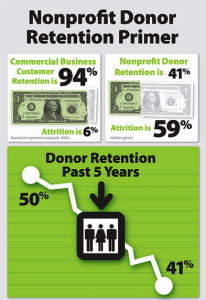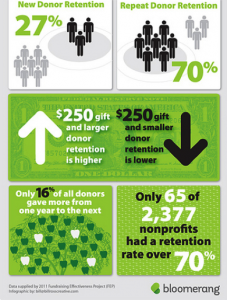

Several months ago Bloomerang published this graphic showing data from a study called the Fundraising Effectiveness Project. Much of the information on here is known to most of us – namely, that donor retention is pretty low. But there were two pieces of information that were particularly interesting to me:
- That only 16% of all donors gave more from one year to the next. I am aware that many donors either go away after their first year or give the same or less in following years. But I did not realize that the percentage of donors giving more was so low.
- That the retention rates of commercial companies are around 94% compared to non-profit donor retention rates hovering around 41%. 94% is an amazing number, and it shows that commercial business managers understand the economics of customer acquisition and retention far better than their non-profit colleagues.
The whole subject of donor retention boils down to one big point: the donor is not happy (for one reason or another), so she just goes away.
As Jeff and I have studied this subject we have concluded that there are two major reasons why donors go away. They are not thanked or appreciated properly and they don’t know their giving is making a difference. I am going to address the concept of “making a difference” in the next post in this series. Right now I want to drill down on thanking, especially as relates to major donors.
Our studies show that donors who are on a caseload and properly managed by a MGO retain as high as 85 to 93% even in organizations where the other donors are being retained between 40-60%. The key words here are “properly managed.” We have seen major donors on mismanaged caseloads where the retention is very low. So, just putting a major donor on a caseload does not assure their retention. I know this is obvious, but you would be amazed how many MGOs and major gift managers do not realize this.
One of the key ways to retain your major donor is to thank them quickly and promptly – regardless of what the receipting and thank-you system in your organization does. I say this because we have seen many situations where, if the MGO left the thanking up to the existing “system,” the donor would be seriously mistreated.
Take the case of the donor who gave an organization he loved $25,000 and was never thanked. The gift got banked but the paperwork and notices never made it out the door. It wasn’t until the donor ran into the CEO of the organization and asked him about it that the CEO embarrassingly discovered that his organization had seriously mismanaged this donor and his generous gift. It turns out that that $25,000 was not the only gift this donor gave. He gave the same amount to 8 different organizations – and only one of them thanked him. Guess who got the whole $200,000 the next year? The organization that thanked him.
Then there’s the $75,000 gift that went missing in another organization. I mean, the paperwork went missing, not the money. Isn’t it interesting that the money doesn’t go missing? This story has all the same elements of the previous story – same book, different chapter. We could tell you dozens of these stories. It is truly tragic.
The common thread running through each of these situations has two elements:
- A leader who does not value donors. Jeff has addressed this need for a culture of philanthropy in his series. Read it, if you haven’t already. If a leader does not value and appreciate where his or her money comes from, it follows that all of those down-line employees and managers will not be held to a high standard of valuing donors. And if you are in that kind of culture, then it is up to you to make sure your caseload donors are thanked promptly and effectively. Take steps to do that.
- A system that does not value donors. You know what this kind of system looks like. In several cases like this, the MGOs we know review organizational receipting records on a daily basis to see if any of their caseload donors have given and when. They then issue a thank-you that goes around the system. True, the donor gets thanked twice – one on time the other later – but the MGO reasons that it is better to thank extra times rather than once, late. So if you are in a situation where your system is slow or inadequate, take things into your own hands and thank that good donor of yours – do the workaround!
Finally, there are a number of good ways to thank donors – I list them here in no particular order of importance. And if you have some other ways, please send them to us so we can share them with our Passionate Giving community. Here are just a few, in addition to the standard thank you letter that goes along with a receipt:
- A handwritten note or email a week following the mailing of the standard letter that says: “Hello, NAME, I was just thinking again about your gift of $XX on DATE. Just can’t tell you how much we all appreciate what you are doing for NAME OF CAUSE. Thank you so much.”
- A call two weeks after the gift with the same messaging as #1 above.
- An email with a link to a video of the area the donor is supporting and a thank you.
- Send a news clipping that addresses the program category the donor is supporting with a little note thanking them again. You can’t do this one enough.
- A picture of a person helped along with a note from THEM thanking the donor.
- A text message with a thank you three or four weeks after they received their regular thank you.
- A note from the CEO or top leader thanking them.
- A note from the CFO thanking that donor with the following message: “I handle the money here at NAME of ORG and sometimes I wonder how we’re going to pay for all of these programs. That’s why your giving is so appreciated. Thank you.” You could even have other division heads write and thank the donor with similar messages.
- A thank you from a community or entertainment VIP or celebrity thanking the donor.
- A picture of the recipient with a 1 foot X 2 foot sign that says: “Thank you, NAME of donor.”
- Any kind of tactic that will surprise the donor – and it can be done multiple times after the gift. You cannot thank the donor enough.
Thanking donors is a big deal. Very big. And as a MGO you cannot afford to let this area slide. An un-thanked or poorly-thanked major donor is a donor that is walking toward the back door of your organization, getting ready to leave. Don’t let that happen.
Richard
Series details:



This was a particularly good one, Richard. Great stats and idea starters…thanks!
I’m new to your blog, this was the first I read and it’s a great one! I fundraise as an individual, not a corporate fundraiser, but, have to say I find the Thank You to each and every donor, makes a huge difference, it definitely is as you say A Big Deal! Thanks!